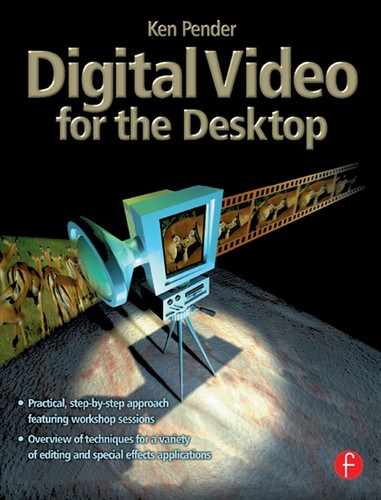As we have seen from the examples included in this book, the age of video editing on the desktop has truly arrived, making possible the integration of a wide range of exciting video and audio effects with the aid of quite moderately priced hardware and software. Remarkably, this new capability includes the capture and conversion of analogue video for storage and editing on the hard drive and merging with new digital video sequences created on the desktop, before conversion and output of the hybrid results back to analogue tape.
Already it is possible to apply to individual video frames, or to whole video clips, many of the sophisticated image editing effects now available in leading edge drawing, painting and photoediting applications. Fast developing animation techniques on the desktop are also making it possible to integrate sophisticated animation into video productions, using complex reflection, texturing and transparency techniques and environmental variables like mist and fog. Simulated studio lighting and camera effects can further enhance the realism of scenes.
Television pictures are recorded – and are now being transmitted – in digital rather than analogue form. For television broadcasting, this will mean elimination of interference, while for video recording, it will mean virtually perfect reproduction
Digital video cameras are becoming available which allow direct down-loading to the desktop, avoiding the complexity of analogue to digital conversion. After editing, the digital footage can be uploaded to a fresh tape in the camera’s digital VCR, once again avoiding digital to analogue conversion.
With the rapid progress towards digital film and television, movie and TV images will soon be as much at home displayed on the family PC screen as on the cinema screen or TV set and DVD technology will dramatically extend the range of digital material available as well as the capacity to store, update and distribute new material. In this new digital world, truly interactive multimedia will realise its full potential and virtual reality will become, well, a reality!
Just as the boundaries between digital vector drawing, photoediting and painting applications have becoming increasingly blurred in recent years, as many of their features have converged, we are now seeing this convergence extending to videoediting applications; already, many of the image adjustment tools, filters, and text generators familiar to the still-image graphic designer, can be found in video editing applications.
It is the arrival of the PC which has empowered the individual to enter the arena of editing the moving image. Video on the desktop has arrived, but is still only in its infancy. As the cost/performance of desktop hardware continues its relentless progress, and as the video editing process becomes digital from input to output, the next decade is set to see a DTV revolution which will rival the DTP revolution of the last decade.
